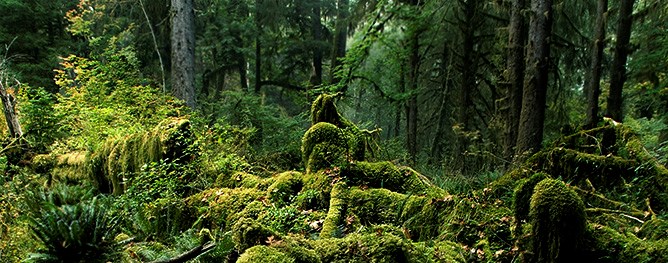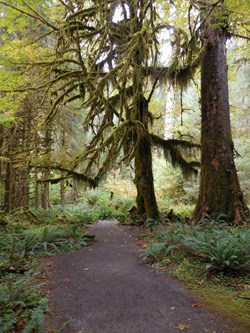Funny Puppies Pathways of Canopies of

Photo by Ken and Mary Campbell
Overview
The Hoh Rain Forest, pronounced "Hoe", earns its name from the ever-flowing Hoh River that carves its way from Mount Olympus towards the Pacific Coast. However, where the name originates, is up for debate. The word "Hoh" undoubtedly comes from Native American languages; possibly the Quileute word "Ohalet" which means "fast moving water" or "snow water." Since the river itself forms from glacial runoff, that origin seems straightfoward. Other explanations state that the Quinault word "Qu," meaning "boundary," could be the root of the name as a river as massive as the Hoh certainly forms a formidable boundary across the landscape. A third consideration claims that the word "Hoh" translates to "man with quarreling wives." What the actual history behind the name is appears to be lost to time.
Regardless of the name, there's no question as to the allure that draws visitors back to the rainforest year after year. Throughout the winter season, rain falls frequently in the Hoh Rain Forest, contributing to the yearly average of 140 inches (3.55 meters) of precipitation each year. The result is a lush, green canopy of both coniferous and deciduous species. Mosses and ferns that blanket the surfaces add another dimension to the enchantment of the rainforest.
The Hoh Rain Forest is located in the stretch of the Pacific Northwest rainforest which once spanned the Pacific coast from southeastern Alaska to the central coast of California. The Hoh is one of the finest remaining examples of temperate rainforest in the United States and is one of the park's most popular destinations.
The Hoh lies on the west side of Olympic National Park, about a two-hour drive from Port Angeles and under an hour from Forks. The Hoh Rain Forest is accessed by the Upper Hoh Road, off of Highway 101 (directions).
A general map and information regarding facilities, picnic areas, camping, and regulations can be found on the park's Hoh Rain Forest brochure.

NPS Photo
Places to Stay
The Hoh Rain Forest has a campground that is open year round, with 72 sites located in the old growth forest along the river. All campsites are reservable during the peak season and reservations are available online six months in advance at recreation.gov.
There are also places to stay just outside the park boundary, and in the town of Forks, less than a one-hour drive by car.
Information about lodging can be found through the Forks Chamber of Commerce website.
Recreation
The trailhead for this area is located at the end of the Upper Hoh Road next to the Hoh Rain Forest Visitor Center , which is a great place for more information. The staff there can give you ideas for your visit and exhibits will help explain what makes this area so special. The visitor center is open daily during the summer, closed January through early March, and generally open Friday through Sunday during the spring and fall seasons (hours may vary according to season).
The area offers two short loop trails as well as an out-and-back trail through the forest near the Visitor Center.
- The Hall of Mosses Trail (.8 miles/ 1.2 km) is an iconic loop that takes you through old growth forest and features a grove of maples trees draped with abundant club moss.
- The Spruce Nature Trail (1.2 miles/ 1.9 km) is a diverse trail that loops through both old and new growth forest as you walk alongside Taft Creek and the Hoh River.
- The Hoh River Trail is the area's main hiking trail. This out-and-back trail can be taken as far as one desires. Taken all the way, it leads past multiple camping areas, the last being Glacier Meadows at 17.3 miles (27.8 km), and ultimately ends 18.5 miles/ 30 km out at the Blue Glacier moraine looking up at Mt. Olympus. The Hoh Lake Trail branches off from the Hoh River trail just after the ranger station and ascends to Bogachiel Peak between the Hoh and the Sol Duc Valley. For those wanting to explore this area as a day hike, there are additional popular turn-around points along the trail.
- First River access (0.9 miles/ 2.9 km one way)
- Mineral Creek Falls (2.7 miles/ 4.3 one way)
- Cedar Grove (4.0 miles/ 6.4 km one way)
- 5 mile Island (5.0 miles/ 8.0 km one way)
To get permits and more information on backpacking along the Hoh River Trail and throughout Olympic National Park, visit the Wilderness (Backcountry) Reservations page.
Pets are not allowed on trails in the Hoh Rain Forest. Visit our Pets page for more information on where you can take your pet in the park.
Nearby Areas
Several coastal areas within Olympic National Park, as well as the town of Forks, can be reached in less than one hour by car from the Hoh. Before you come, make sure to visit the Getting Around page for mileages to different park destinations.
Flora and Fauna of the Hoh
Imagine a climate that rains most of the year. Its average summer temperatures don't reach above the mid 70s F or low 20s C. The undergrowth is dense and the canopy is thick, providing shade until an old growth giant falls. This is the life in a temperate rainforest. If you were an animal here, where would you live? If you were a plant, how might you survive? The flora and fauna of the Hoh are unique and abundant. So what might you see?
It is always exciting to see animals in our lush forests. It is common for visitors to spot large mammals like Roosevelt Elk, Black Bears, and River Otter. One may also spot signs of more elusive animals such as Bobcat and Mountain Lions that are more active at night. The overgrown forest floor provides the perfect habitat for animals like banana slugs , snails, rodents, snakes, and salamanders. Among the treetops, you may hear birds sing. We often see American Robins, Barred Owls, and Canada Grey Jays. The old growth provides a special habitat for the endangered Northern Spotted Owl, so remember to respect the home of these animals during your visit!
The Hoh is home to some of North America's giants. As you traverse the trails, you may feel miniscule in comparison to the Sitka Spruce, Red Cedar, Big Leaf Maple and Douglas Fir that thrive here. Check out the Tree ID guide to navigate the forest and know which trees you're hiking with! These tall trees darken the ecosystem below them, giving much loved shade to the hundreds of mosses and ferns below. A skylight only opens once one of these giants collapses, providing not only sunlight, but nutrition and new life to the forest that may grow upon its fallen trunk. These nursery logs can be seen throughout the forest in varying stages of decay. Do you see the new growth just sprouting? Can you see evidence from an oddly straight line of now-towering trees, perhaps still with space below their roots where a nursery log once gave nutrients and protection? This forest is teeming with life around every root. The variety of greens will thrill the eye as you hike through natural history.
Visit the Hoh Rain Forest Photo Gallery on Flickr
Source: https://www.nps.gov/olym/planyourvisit/visiting-the-hoh.htm
0 Response to "Funny Puppies Pathways of Canopies of"
Postar um comentário